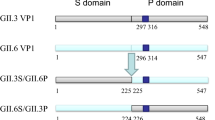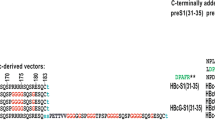Abstract
The surface-exposed loop regions of the protruding domain of the norovirus (NoV) major capsid protein VP1 can tolerate the insertion of foreign antigens without affecting its assembly into subviral particles. In this study, we investigated the tolerance of the surface-exposed loop region of the GII.4 NoV VP1 by replacing it with homologous or heterologous sequences. We designed a panel of constructs in which the amino acid sequence from position 298-305 of the GII.4 NoV VP1 was replaced by sequences derived from the same region of GI.3, GII.3, GII.6, and GII.17 NoVs as well as neutralizing epitopes of enterovirus type 71 and varicella-zoster virus. The constructs were synthesized and expressed using a recombinant baculovirus expression system. The expression of target proteins was measured by indirect enzyme-linked immunosorbent assay (ELISA), and the assembly of virus-like particles (VLPs) was confirmed by electron microscopy. Our results showed that all of the constructs expressed high levels of target chimeric proteins, and all of the chimeric proteins successfully assembled into VLPs or subviral particles. An in vitro VLP-histo-blood group antigen (HBGA) binding assay revealed that chimeric-protein-containing VLPs did not bind or showed reduced binding to salivary HBGAs, a ligand for NoV particles. The results of an in vitro VLP-HBGA binding blockade assay indicated that the predicted surface-exposed loop region of the GII.6 NoV VP1 may comprise a blockade epitope. In summary, the surface-exposed loop region of the GII.4 NoV VP1 can be replaced by foreign sequences of a certain length. Using this strategy, we found that the predicted surface-exposed loop region of GII.6 NoV VP1 might contain a blockade epitope.






Similar content being viewed by others
References
Jiang X, Wang M, Graham DY, Estes MK (1992) Expression, self-assembly, and antigenicity of the Norwalk virus capsid protein. J Virol 66(11):6527–6532
Huo Y, Wan X, Ling T, Wu J, Wang W, Shen S (2018) Expression and purification of norovirus virus like particles in Escherichia coli and their immunogenicity in mice. Mol Immunol 93:278–284
Prasad BV, Rothnagel R, Jiang X, Estes MK (1994) Three-dimensional structure of baculovirus-expressed Norwalk virus capsids. J Virol 68(8):5117–5125
Prasad BV, Hardy ME, Dokland T, Bella J, Rossmann MG, Estes MK (1999) X-ray crystallographic structure of the Norwalk virus capsid. Science 286(5438):287–290
Tan M, Fang P, Chachiyo T, Xia M, Huang P, Fang Z et al (2008) Noroviral P particle: structure, function and applications in virus-host interaction. Virology 382(1):115–123
Tan M, Jiang X (2012) Norovirus P particle: a subviral nanoparticle for vaccine development against norovirus, rotavirus and influenza virus. Nanomedicine (Lond) 7(6):889–897
Ming T, Ming X, Huang P, Wang L, Zhong W, Mcneal M et al (2011) Norovirus P particle as a platform for antigen presentation. Procedia Vaccinol 4:19–26
Zheng L, Wang W, Liu J, Huo Y, Qin C, Wang M et al (2017) Comprehensive characterization of a major capsid protein derived from a documented GII.6 norovirus strain. Arch Virol 162(12):3863–3868
Huo Y, Wang W, Zheng L, Chen X, Shen S, Wang M (2017) Enzymatic cleavage promotes disassembly of GII.3 norovirus virus like particles and its binding to salivary histo-blood group antigens. Virus Res 240:18–24
Qiu S, Zheng L, Qin C, Yin X, Ma J, Liu J et al (2020) Production and characterization of monoclonal antibodies against GII.6 norovirus virus-like particles. Microb Pathog 142:104100
Foo DG, Alonso S, Phoon MC, Ramachandran NP, Chow VT, Poh CL (2007) Identification of neutralizing linear epitopes from the VP1 capsid protein of Enterovirus 71 using synthetic peptides. Virus Res 125(1):61–68
Zhu R, Liu J, Chen C, Ye X, Xu L, Wang W et al (2016) A highly conserved epitope-vaccine candidate against varicella-zoster virus induces neutralizing antibodies in mice. Vaccine 34(13):1589–1596
Zhang G, Wang J, Liu J, Zheng L, Wang W, Huo Y et al (2019) The surface-exposed loop region of norovirus GII.3 VP1 plays an essential role in binding histo-blood group antigens. Arch Virol 164(6):1629–1638
Zheng L, Wang W, Liu J, Chen X, Li S, Wang Q et al (2018) Characterization of a Norovirus-specific monoclonal antibody that exhibits wide spectrum binding activities. J Med Virol 90(4):671–676
Huo Y, Wan X, Ling T, Shen S (2016) Biological and immunological characterization of norovirus major capsid proteins from three different genotypes. Microb Pathog 90:78–83
Huo Y, Wan X, Wang Z, Meng S, Shen S (2015) Production of Norovirus VLPs to size homogeneity. Virus Res 204:1–5
White LJ, Hardy ME, Estes MK (1997) Biochemical characterization of a smaller form of recombinant Norwalk virus capsids assembled in insect cells. J Virol 71(10):8066–8072
Debbink K, Lindesmith LC, Donaldson EF, Swanstrom J, Baric RS (2014) Chimeric GII.4 norovirus virus-like-particle-based vaccines induce broadly blocking immune responses. J Virol 88(13):7256–7266
Acknowledgements
The authors thank all the members of the laboratory for their contributions.
Funding
This research was supported by the Chinese Federation of Public Health Foundation (GWLM202003).
Author information
Authors and Affiliations
Contributions
YH and QZ conceived and designed the experiments; JM, LZ, JL, ZY, and CW performed the experiments. JM and LZ analyzed the data; YH prepared the manuscript.
Corresponding authors
Ethics declarations
Conflict of interest
The authors declare no conflicts of interest.
Ethical approval
Animal experiments were carried out at Wuhan Dia-an, following the guidelines of the Chinese Council on Animal Care.
Additional information
Handling Editor: Tim Skern.
Publisher's Note
Springer Nature remains neutral with regard to jurisdictional claims in published maps and institutional affiliations.
Supplementary Information
Below is the link to the electronic supplementary material.
Rights and permissions
About this article
Cite this article
Huo, Y., Ma, J., Zheng, L. et al. Expression of chimeric proteins based on a backbone of the GII.4 norovirus VP1 and their application in the study of a GII.6 norovirus-specific blockade epitope. Arch Virol 167, 819–827 (2022). https://doi.org/10.1007/s00705-022-05362-5
Received:
Accepted:
Published:
Issue Date:
DOI: https://doi.org/10.1007/s00705-022-05362-5




